I always tell students that unless you are using the exact same yarn in the exact same way that you have used it before, then your project is an experiment. Call it a full-size sample if you want to.
I’m OK with that. Who wants to do the same thing over and over? This is my latest warp. I wound 13 yards of mixed Solano County wool yarns. These are yarns that I have had spun in the last few years from the Timm Ranch, Anderson Ranch, and my own flock. Most were dyed with black walnuts–it’s amazing the range of colors you can get when you use a black walnut dye pot over and over…and over. It keeps on giving color. Look at the range of browns in the photo below.
This is my latest warp. I wound 13 yards of mixed Solano County wool yarns. These are yarns that I have had spun in the last few years from the Timm Ranch, Anderson Ranch, and my own flock. Most were dyed with black walnuts–it’s amazing the range of colors you can get when you use a black walnut dye pot over and over…and over. It keeps on giving color. Look at the range of browns in the photo below. The other thing to notice about this photo is that the last piece woven on it is so much narrower than the others. This was the fourth shawl on the warp. The one before this one is a different weave structure (advancing twill treadling), but the first two are the same structure as the fourth one. The only difference is the weft yarn. The first three shawls were woven with 2015 Timm Ranch yarn on cones. The weft for the fourth shawl is 2016 Timm Ranch yarn that has been dyed. This is a perfect example of the difference that “finishing” yarn can make.
The other thing to notice about this photo is that the last piece woven on it is so much narrower than the others. This was the fourth shawl on the warp. The one before this one is a different weave structure (advancing twill treadling), but the first two are the same structure as the fourth one. The only difference is the weft yarn. The first three shawls were woven with 2015 Timm Ranch yarn on cones. The weft for the fourth shawl is 2016 Timm Ranch yarn that has been dyed. This is a perfect example of the difference that “finishing” yarn can make.  This is one of the previous batch of shawls. It is mostly Jacob yarn but the weft is last year’s Timm Ranch/Jacob blend used from a cone without washing. In this case the width of the warp in the reed was 30″ with a sett of 6 epi. That is very open but when wet finished the shawl is lightweight and has great drape. However, the finished width is only about 20″ (33% draw-in and shrinkage). So I sett the brown warp the same at 6 epi but started with a 39″ wide warp.
This is one of the previous batch of shawls. It is mostly Jacob yarn but the weft is last year’s Timm Ranch/Jacob blend used from a cone without washing. In this case the width of the warp in the reed was 30″ with a sett of 6 epi. That is very open but when wet finished the shawl is lightweight and has great drape. However, the finished width is only about 20″ (33% draw-in and shrinkage). So I sett the brown warp the same at 6 epi but started with a 39″ wide warp.
 Here are the shawls from the brown warp after wet finishing. That one that was so much narrower on the cloth beam? That is the one that is a little wider here. It is now 27″ wide (30% draw-in and shrinkage). The shawl in the same pattern but woven with the white weft is 26″ wide (33% draw-in and shrinkage). The difference between width in the reed and the finished piece isn’t much, but the photos show the dramatic difference in how the yarn behaves while it is woven.
Here are the shawls from the brown warp after wet finishing. That one that was so much narrower on the cloth beam? That is the one that is a little wider here. It is now 27″ wide (30% draw-in and shrinkage). The shawl in the same pattern but woven with the white weft is 26″ wide (33% draw-in and shrinkage). The difference between width in the reed and the finished piece isn’t much, but the photos show the dramatic difference in how the yarn behaves while it is woven.  Here is a before and after photo. The bottom shawl has been wet finished. The top one is the same weft yarn and same pattern, but has not been washed. Look at the very first photo in this post. You can see how wide open the yarns are. Off the loom they are a little closer, but that looks nothing like it will when finished.
Here is a before and after photo. The bottom shawl has been wet finished. The top one is the same weft yarn and same pattern, but has not been washed. Look at the very first photo in this post. You can see how wide open the yarns are. Off the loom they are a little closer, but that looks nothing like it will when finished.  An example of trying to take product photos with the help of a Border Collie.
An example of trying to take product photos with the help of a Border Collie. Here is one of the final product photos. I noticed a surprise. I started to see a purple cast to one of the warp yarns. At first I thought that I just hadn’t noticed that shade inside while I was weaving. I tried to convince myself that it was still brown.
Here is one of the final product photos. I noticed a surprise. I started to see a purple cast to one of the warp yarns. At first I thought that I just hadn’t noticed that shade inside while I was weaving. I tried to convince myself that it was still brown. Do you see it here?
Do you see it here?  Another photo of one not washed (no purple) and one washed. I lined up the same warp threads in these two pieces.
Another photo of one not washed (no purple) and one washed. I lined up the same warp threads in these two pieces.  Depending on the light setting in the photo (and maybe your monitor) you may see it more clearly in one of these other photos.
Depending on the light setting in the photo (and maybe your monitor) you may see it more clearly in one of these other photos. In person it is clearly visible, although it doesn’t stand out.
In person it is clearly visible, although it doesn’t stand out.
The answer…that was a yarn dyed with mushrooms from a friend. It must have been rhe soap that caused the shift in color. I love it. Lisa, what is the name of that?














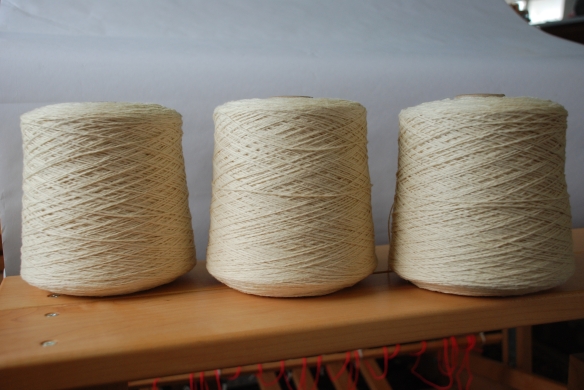 I hadn’t had a chance to do anything with it until recently. The first step was to gather some information.
I hadn’t had a chance to do anything with it until recently. The first step was to gather some information.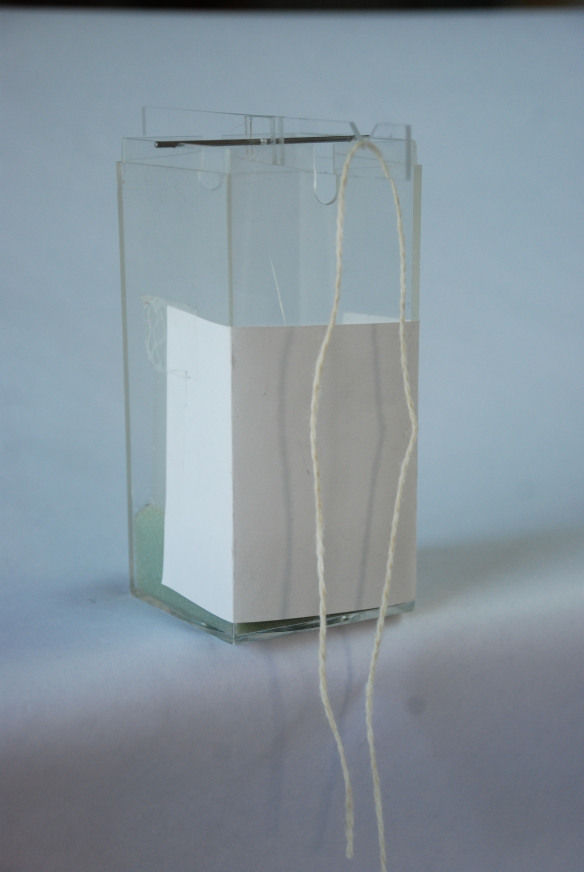 The McMorran yarn balance is one tool to do that. You trim the ends off a strand of yarn until the arm balances.
The McMorran yarn balance is one tool to do that. You trim the ends off a strand of yarn until the arm balances.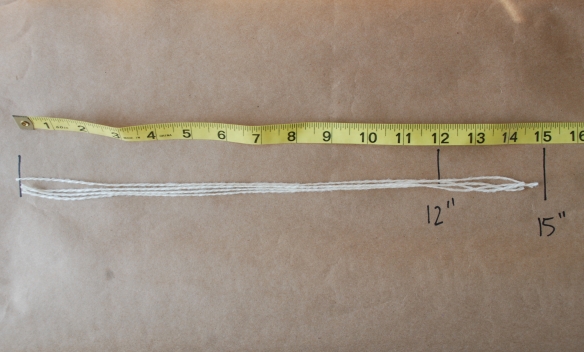 Then you measure that length of yarn and multiply by 100 to get ypp (yards/pound). I repeated that a few times to get an average–1500 ypp.
Then you measure that length of yarn and multiply by 100 to get ypp (yards/pound). I repeated that a few times to get an average–1500 ypp.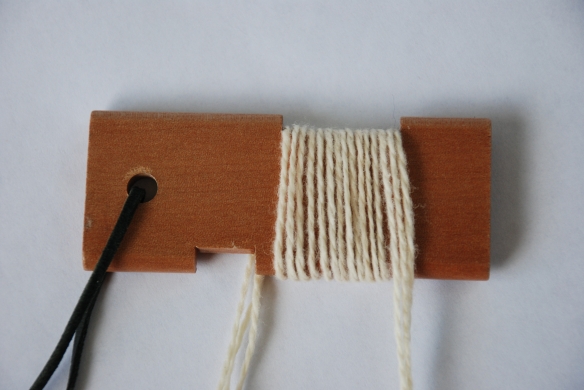 Another measurement is wpi (wraps/inch). This yarn measure 15 wpi. However, from past experience I know that this isn’t quite accurate. Most yarn is scoured (washed) and skeined before it is sold in yarn stores. That can have a dramatic effect on the yarn. The yarn that I got from the mill on cones has not been scoured yet, so it is not really “finished”.
Another measurement is wpi (wraps/inch). This yarn measure 15 wpi. However, from past experience I know that this isn’t quite accurate. Most yarn is scoured (washed) and skeined before it is sold in yarn stores. That can have a dramatic effect on the yarn. The yarn that I got from the mill on cones has not been scoured yet, so it is not really “finished”.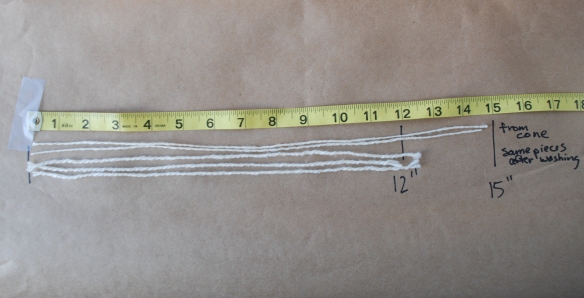 Look at the difference a soak in warm water makes. Now this yarn measure 1200 ypp (which is what the specs from the mill were)…
Look at the difference a soak in warm water makes. Now this yarn measure 1200 ypp (which is what the specs from the mill were)… and it is 10 wpi. Based on those measurements I wove some samples.
and it is 10 wpi. Based on those measurements I wove some samples.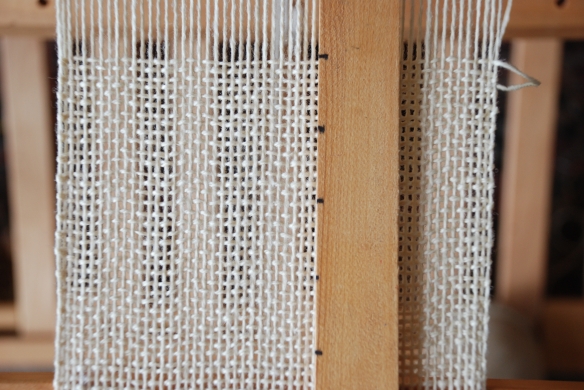 These samples look pretty open on the loom…
These samples look pretty open on the loom…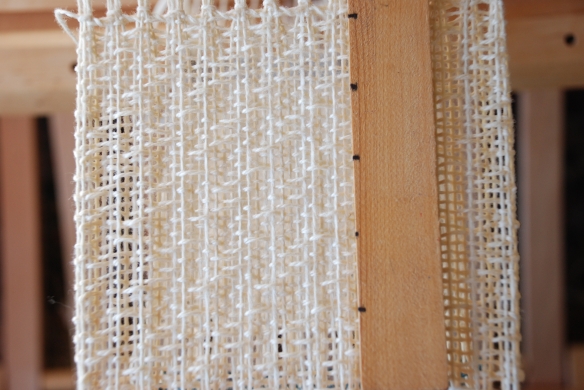 …and I had to be careful to not beat the weft yarn down too much.
…and I had to be careful to not beat the weft yarn down too much.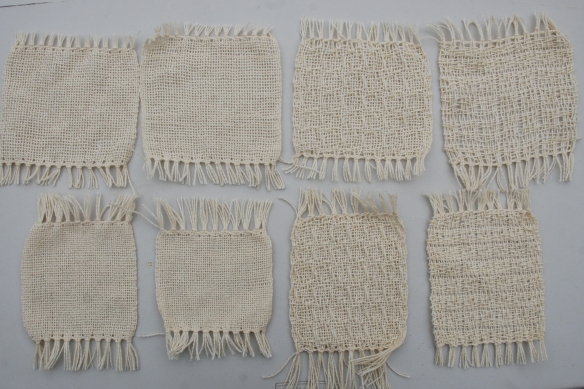 This is how the samples look off the loom. The 8 epi samples are in the top row.
This is how the samples look off the loom. The 8 epi samples are in the top row. And here is how they look after a quick wash. Dramatic difference from the loom to the finished fabric.
And here is how they look after a quick wash. Dramatic difference from the loom to the finished fabric.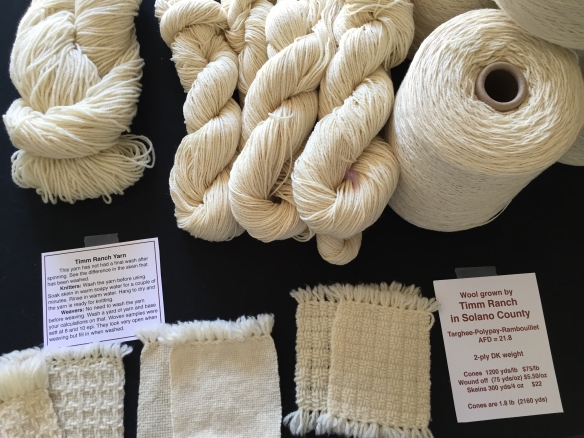 Here is how I had them displayed in the shop at the recent Shearing Day. The skein on the left has been washed. But these yarns aren’t just for weaving. My friend, Mary, bought some, washed it, and then used it for a Mystery Knit Along. Here is the shawl she knit.
Here is how I had them displayed in the shop at the recent Shearing Day. The skein on the left has been washed. But these yarns aren’t just for weaving. My friend, Mary, bought some, washed it, and then used it for a Mystery Knit Along. Here is the shawl she knit. This was knit over a few weeks with a new direction given out each week.
This was knit over a few weeks with a new direction given out each week. It is gorgeous in person and has a wonderful hand. I can’t wait to get some of this yarn on the loom and get to work with it.
It is gorgeous in person and has a wonderful hand. I can’t wait to get some of this yarn on the loom and get to work with it.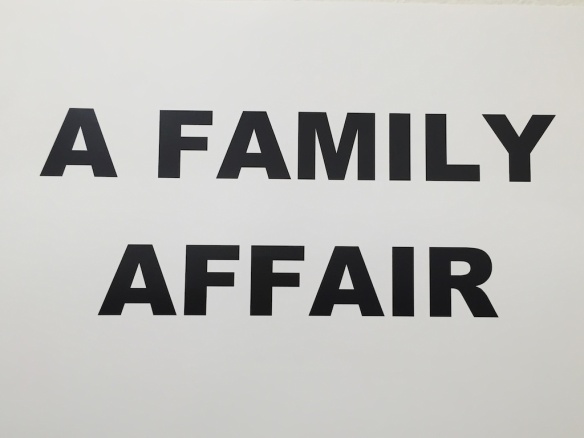 For this month’s show we invited our family members to join us in sharing their art work.
For this month’s show we invited our family members to join us in sharing their art work.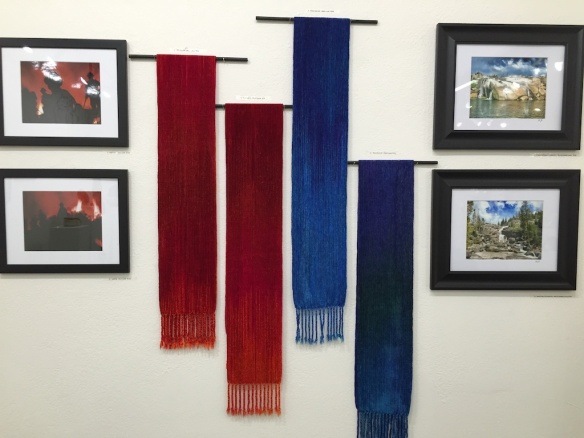 My sons and daughter-in-law entered their photos. Sorry that my photos don’t show theirs very well. Chris took photos while on the fire line last summer. Matt and Kaleena’s photos are taken in their “backyard” of the El Dorado National Forest. I wove 7 Fire scarves and 5 Sky scarves so that I could choose the ones I wanted to display with the photos. You can’t tell from this but the Fire scarves have sparkles (and have a lot more color variation than shows up here).
My sons and daughter-in-law entered their photos. Sorry that my photos don’t show theirs very well. Chris took photos while on the fire line last summer. Matt and Kaleena’s photos are taken in their “backyard” of the El Dorado National Forest. I wove 7 Fire scarves and 5 Sky scarves so that I could choose the ones I wanted to display with the photos. You can’t tell from this but the Fire scarves have sparkles (and have a lot more color variation than shows up here).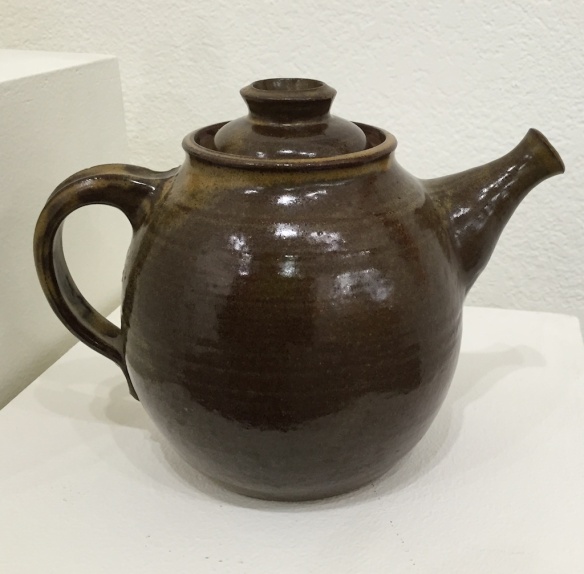 I also included two of my mom’s pieces. She was always proud of her teapots because she could create a dripless spout.
I also included two of my mom’s pieces. She was always proud of her teapots because she could create a dripless spout. 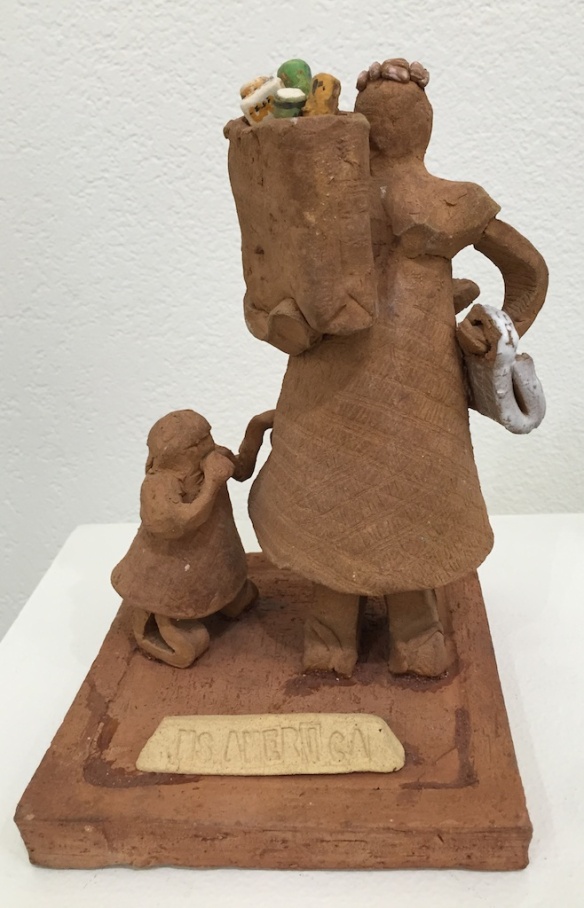 Mom mostly made functional pieces like plates, bowls, and mugs, but also made tiles for the kitchen, a bathroom sink (the actual sink !), lanterns, birdbaths, and a sundial. This is a rare statement on society…
Mom mostly made functional pieces like plates, bowls, and mugs, but also made tiles for the kitchen, a bathroom sink (the actual sink !), lanterns, birdbaths, and a sundial. This is a rare statement on society…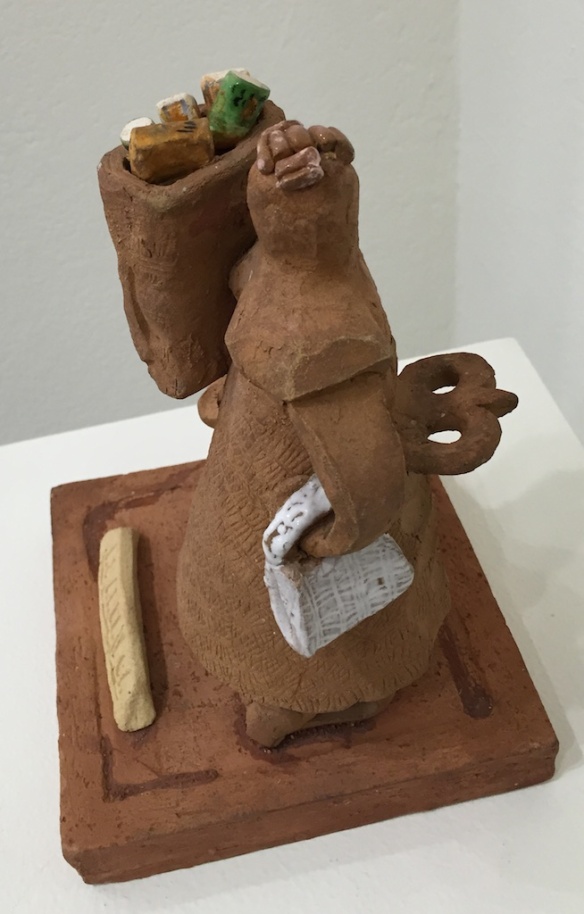 …but I’m not really sure what she meant.
…but I’m not really sure what she meant. I took only a few more photos in the gallery because I ran out of time. Artery member Marjan made the 3-D flowers and her mom did the silk paintings.
I took only a few more photos in the gallery because I ran out of time. Artery member Marjan made the 3-D flowers and her mom did the silk paintings.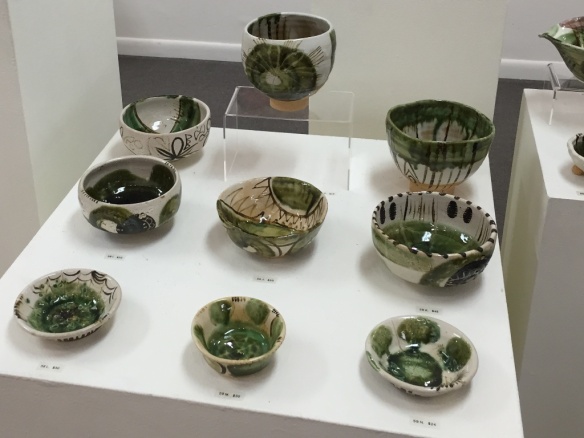 Heidi’s husband and dad collaborated with her making bowls.
Heidi’s husband and dad collaborated with her making bowls.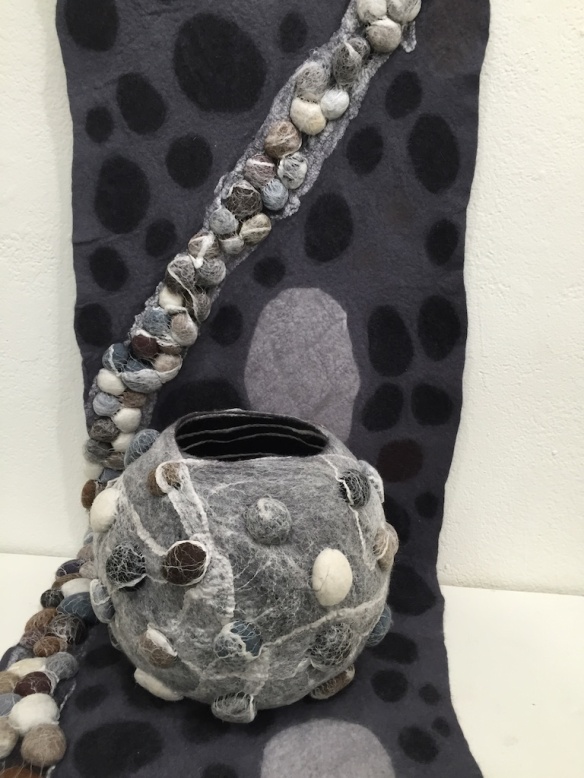 Sorry, but I don’t remember whose work this is but it is all felt, including the rocks.
Sorry, but I don’t remember whose work this is but it is all felt, including the rocks.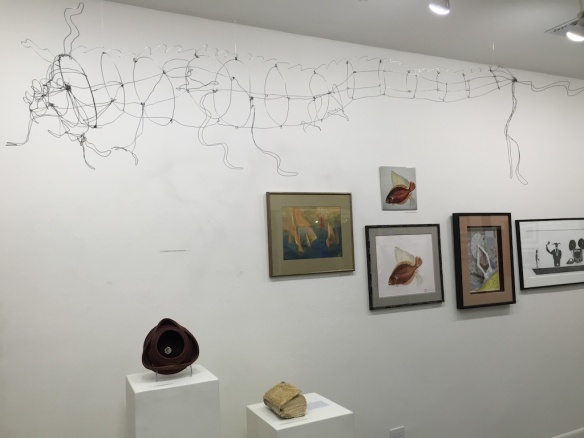 Here is a wild “Dragon Drawn in Space” above member Chris’ family’s art.
Here is a wild “Dragon Drawn in Space” above member Chris’ family’s art. My regular work moved out of the gallery and is in the front of the Artery for the next month or two.
My regular work moved out of the gallery and is in the front of the Artery for the next month or two.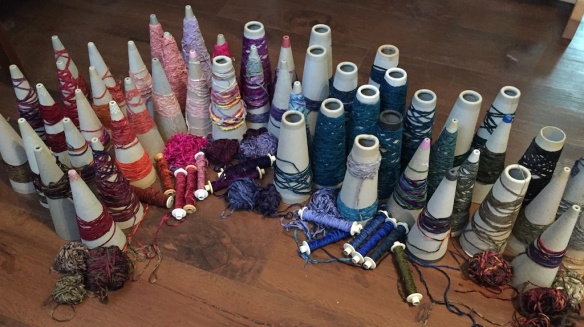 Three yards (or a little less) is the length I need to make a scarf. I dumped out a couple of bags of leftover chenille and organized it by color. This made two warps.
Three yards (or a little less) is the length I need to make a scarf. I dumped out a couple of bags of leftover chenille and organized it by color. This made two warps.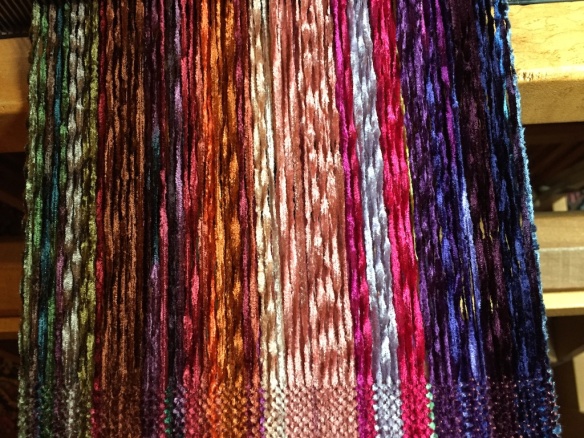 The first uses the yarns on the left side of the upper photo, going into the purple range.
The first uses the yarns on the left side of the upper photo, going into the purple range.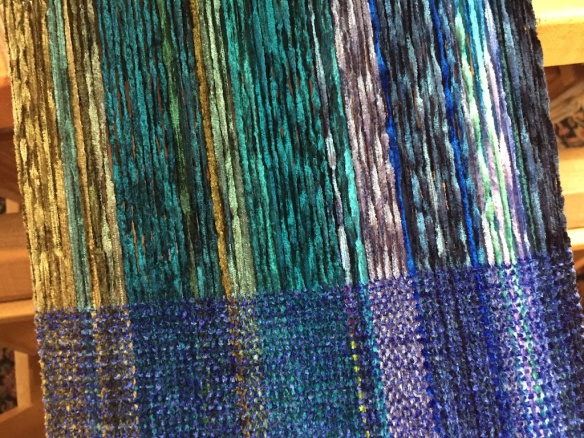 The color isn’t very good on this photo but this was mostly yarns from the right side. Here are the finished pieces:
The color isn’t very good on this photo but this was mostly yarns from the right side. Here are the finished pieces: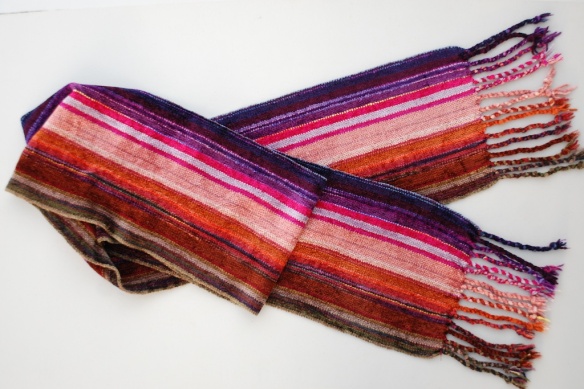 I used a fine cotton weft for this scarf mainly because I couldn’t figure out which color of chenille would work across all of these stripes. By using a fine weft the color of that disappears and the eye sees just the warp color.
I used a fine cotton weft for this scarf mainly because I couldn’t figure out which color of chenille would work across all of these stripes. By using a fine weft the color of that disappears and the eye sees just the warp color.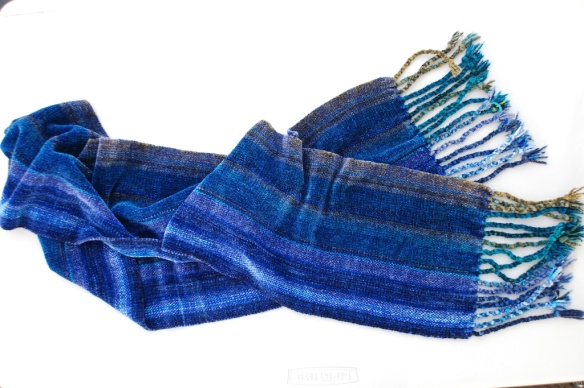 This scarf was different. I used a blue chenille weft. The blue dominates but pulls all the other colors together.
This scarf was different. I used a blue chenille weft. The blue dominates but pulls all the other colors together.




 Here is the problem. When threading the heddles I inadvertently used 7 heddles from the Shaft #5 when I should have used Shaft #4. This is a 4-shaft structure so #5 didn’t lift at all. It is an easy fix for the second blanket. Just tie Shaft # 5 up to each treadle in which Shaft #4 is engaged.
Here is the problem. When threading the heddles I inadvertently used 7 heddles from the Shaft #5 when I should have used Shaft #4. This is a 4-shaft structure so #5 didn’t lift at all. It is an easy fix for the second blanket. Just tie Shaft # 5 up to each treadle in which Shaft #4 is engaged. 
 However, the only way to fix Blanket #1 was to needle weave all 7 threads in after it was off the loom. That should be easy (over-under-over;over-under-under), but it took hours because of the nature of the boucle yarn. Thank goodness it was only 7 threads.
However, the only way to fix Blanket #1 was to needle weave all 7 threads in after it was off the loom. That should be easy (over-under-over;over-under-under), but it took hours because of the nature of the boucle yarn. Thank goodness it was only 7 threads.


 My old teddy bear (I won’t tell you how old) featured in some of the shots too.
My old teddy bear (I won’t tell you how old) featured in some of the shots too.









 This was growing inside that pile.
This was growing inside that pile.


 Even if the rams don’t get to go to the city, some of them are having fun. It’s time to breed my ewes that will lamb at the State Fair. This is Foley and Isadora yesterday. Today it was Crosby and Clover.
Even if the rams don’t get to go to the city, some of them are having fun. It’s time to breed my ewes that will lamb at the State Fair. This is Foley and Isadora yesterday. Today it was Crosby and Clover. 



 into the corner at the end of the room. I didn’t finish until the next day.
into the corner at the end of the room. I didn’t finish until the next day. This is some of the blankets all tagged and ready to show again.
This is some of the blankets all tagged and ready to show again.



